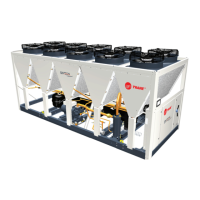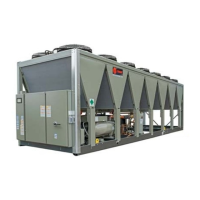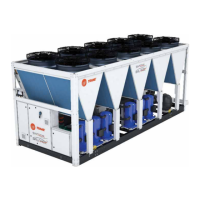RLC-SVX19G-GB
166
4 UNT-PRC002-GB
Technical Data
FWD 08 12 20 30 45
Power supply (V/Ph/Hz) 230/1/50
Capacities
Cooling capacity on water (1) (kW) 5,2 8,3 15 18,8 30,1
Heating capacity on water (2) (kW) 6,3 11,9 18,9 20,9 38,2
Fan motor (type) 2 x direct drive centrifugal
Fan power input (3) (kW) 0,23 0,46 0,65 1,04 1,51
Current amps (3) (A) 1,1 2,2 3,1 4,7 5,5
Start-up amps (A) 3,2 5,5 9,3 14,1 16,5
Air flow
minimum (m
3
/h) 490 980 1400 1800 2700
nominal (m
3
/h) 820 1650 2300 3000 4500
maximum (m
3
/h) 980 1970 2600 3600 5400
Main coil
Water entering/leaving connections (type) ISO R7 rotating female
(Dia) 3/4" 3/4" 1 1/2" 1 1/2" 1 1/2"
Electric heater (accessory for blower only)
Electric power supply (V/Ph/Hz) 230/1/50 230/1/50 or 400/3/50 400/3/50 400/3/50 400/3/50
Heating capacity (kW) 2/4 8 10 12 12
Hot water coil (accessory for blower only)
Heating capacity (4) (kW) 6,3 12 17,4 22,4 34,5
G2 filter (filter box accessory)
Quantity 2 2 2 2 2
Dimensions ( LxWxth) (mm) 386x221x8 486x271x8 586x321x8 586*421*8 586*621*8
G4 filter (filter box accessory)
Quantity - 2 2 2 2
Dimensions ( LxWxth) (mm) - 486x264x48 586x314x48 586*414*48 586*614*48
Condensate pump (accessory) (type) Centrifugal
Water flow - lift height (l/h - mm) 24 - 500
Not available for FWD30 and FWD45
Sound level (L/M/H speed)
Sound pressure level (5) (dB(A)) 36/40/43 38/41/44 46/50/53 47/52/57 47/52/58
Sound power level (5) (dB(A)) 46/50/53 48/51/54 56/60/63 57/62/67 57/62/68
Unit dimensions
Width x Depth (mm) 890 x 600 1090 x 710 1290 x 820 1290 x 970 1290 x 1090
Height (mm) 250 300 350 450 650
Shipped unit dimensions
Width x Depth (mm) 933 x 644 1133 x 754 1333 x 864 1333 x 1008 1333*1133
Height (mm) 260 310 360 460 660
Weight (kg) 32 46 61 76 118
Colour galvanised steel
Recommended fuse size
Unit alone (aM/gI) (A) 8/16 8/16 8/16 8/25 8/25
Unit with electric heater (gI) (A) 16 (2kW),25 (4kW) 40 (230V),3*16 (400V) 3*20 3*25 3*25
(1) Conditions: Water entering/leaving temperature: 7/12 °C, Air inlet temperature 27/19°C DB/WB - Nominal air flow
(2) Conditions: Water entering/leaving temperature: 50/45 °C, Air inlet temperature 20°C DB - Nominal air flow
(3) At high speed with nominal air flow.
(4) Water entering/leaving temperature 90/70 °C, air inlet temperature 20 °C DB, Nominal air flow.
(5) A rectangular glass wool duct 1m50 long is placed on the blower.The measurement is taken in the room containing the blower unit.
Heat exchanger operating limits:
FWD:
*water temperature: max 100° C
*absolute service pressure: min 1 bar/max 11 bars
Accessories - Hot water coil:
*water temperature: min. +2° C/max. 100° C
*absolute service pressure: min 1 bar/max 11 bars
Periodic Maintenance
• Possible low discharge superheat at high loads
• High condenser + Subcooler pressure drop
Some of the symptoms of a refrigerant over-charged unit
• Condenser Pressure Limit
• High –Pressure Cutout diagnostic
• More-than-normal number of fans running
• Erratic fan control
• Higher-than-normal compressor power
• Very low discharge superheat at start up if the refrigerant
charge is correct the discharge superheat is between 10°C
and 15°C when the unit is running at full load
• Compressor rattle or grinding sound at start up
Some of the symptoms of an oil over-charged unit
• Larger-than-normal evaporator approach temperatures
(Leaving-water-temperature – Saturated Evaporator
Temperature)
• Low Evaporator-refrigerant Temperature limit
• Low Refrigerant – Temperature Cutout diagnostic
• Low unit capacity
• Low discharge superheat (specially at high loads)
• Compressor rattle or grinding sound
• High oil-sump level after normal shutdown
Some of the symptoms of an oil under-charged unit
• Compressor rattling or grinding sound
• Lower-than-normal pressure drop through oil system
• Seized or Welded compressors
• Low oil-sump level after normal shutdown
• Lower-than-normal oil concentrations in the evaporator
R134a/R513A/R1234ze Field –
Charging Procedure
This procedure should be followed when the unit is
empty of all refrigerant and under vacuum. Add the
charge through the evaporator service valve.
1. Respect refrigerant type on the nameplate and do not
mix R134a with R513A
2. Note the weight of the amount of charge removed.
Compare it to the nameplate value. A difference in
charge may indicate a leak.
3. Attach the charging hose to the evaporator service
valve (9mm [3/8inch] flare). Open the service valve.
4. Add charge to the evaporator to bring the total
circuit charge up to the level indicated in the unit
nameplate.
5. Close the service valve and disconnect the charging
hose.
Chiller settings
Prior starting refrigerant charge optimization, the
technician must insure the following chiller conditions:
• Constant water flow on a air purged circuit is strictly
necessary during the whole operation (water fl ow to be
within allowed operating range)
• A fully loaded chiller is highly recommended for a
successful operation. In case the technician is not able to
ensure a 2 circuit fully loaded chiller then he must lockout
one circuit and perform charge optimization for
1 circuit at a time
• When the refrigerant charge optimization is done per
circuit the chiller load must not be lower than 60%
This procedure should be followed when adding
refrigerant to an undercharged unit:
1. Attach the charging hose to the evaporator service
valve (9mm [3/8inch] flare). Open the service valve.
2. Fix the leaving water set point (water temperature to
be steady as much as possible).
3. Adjust water flow within operating range and keep it
steady.
a) Note approach temperature T1
b) Add 2kg of R134a, R513A or R1234ze refrigerant
c) Note approach temperature T2
d) If Tn - Tn+1 < 0.2 (with n=1 → charge addition
count) then charge is good and optimization is done
e) If Tn - Tn+1 > 0.2 (with n=1 → charge addition
count) then perform steps b) to e) if needed
This procedure should be followed when removing
refrigerant to an overcharged unit:
1. Fix the leaving water set point (water temperature to
be steady as much as possible)
2. Adjust water flow within operating range and keep it
steady
a) Note approach temperature T1
b) Add 2kg of R134a or R513A or R1234ze refrigerant
c) Note approach temperature T2
d) Keep performing step b until Tm+1
- Tm > 0.5 (with m = 1 > charge removal count)
e) Once step d) is confirmed add 4kg of R134a, R513A
or R1234ze refrigerant and note T3
f) If T1-Tn < 0.2 (with n = 3 → charge addition count)
then charge is good and optimization is done
g) If T1-Tn > (with n = 3 → charge addition count) then
perform step e) to f) if needed
Isolation of the Refrigerant Charge
on the Low side of the System
By closing the suction-line service valve, refrigerant
charge can be isolated in the evaporator for maintenance
on the compressor.
Returning the unit to running conditions:
1. Open all the valves.
2. Manually Open EXV for 15 minutes to allow the
refrigerant drain to the evaporator by gravity.
3. Let the unit sit with heaters on to drive refrigerant
out of the oil and warm up the compressor bearings.
Depending upon ambient conditions, this may take
up to 24 hours.
4. After the oil level has returned to normal, the unit
can be put back into operation.

